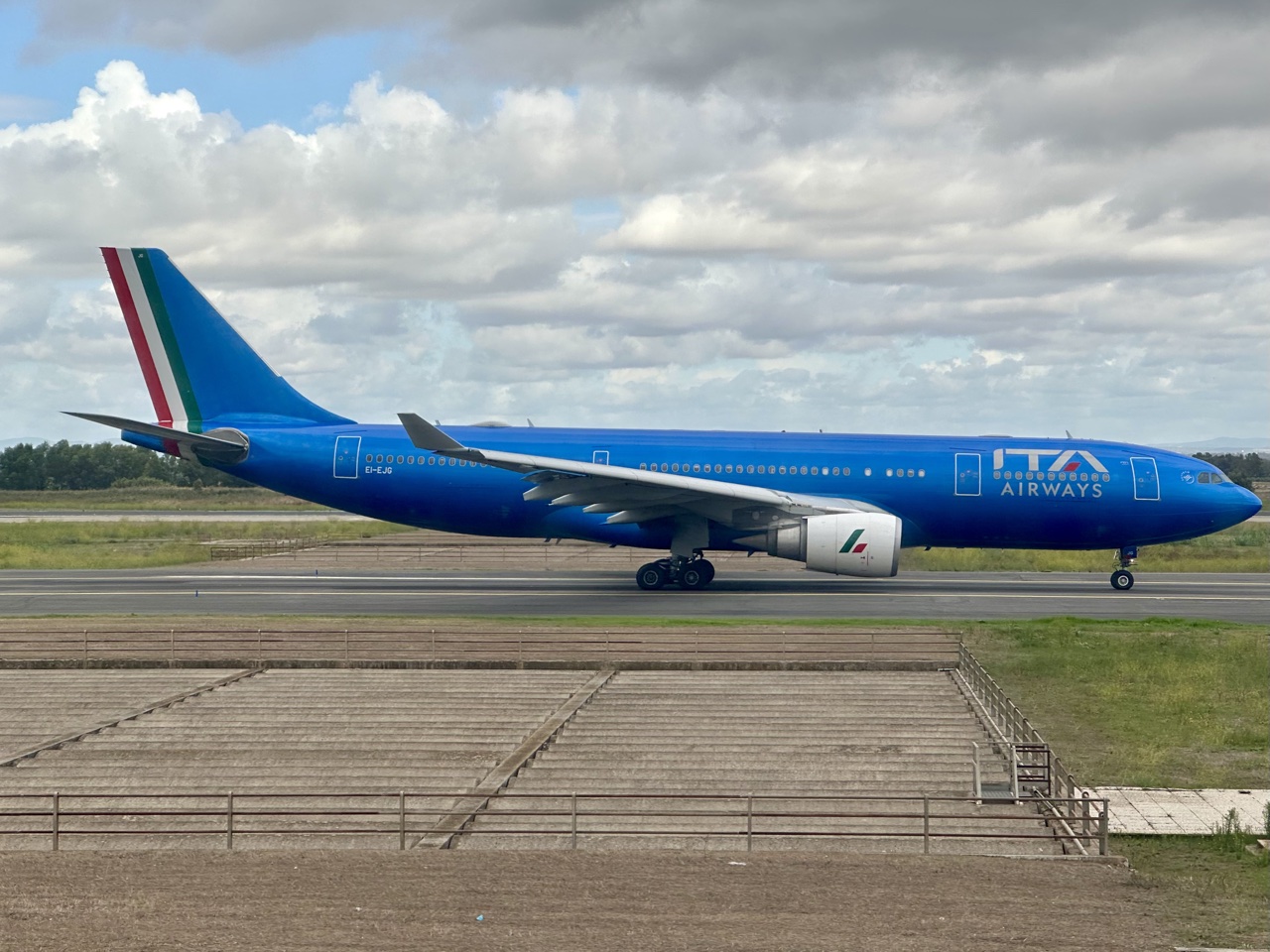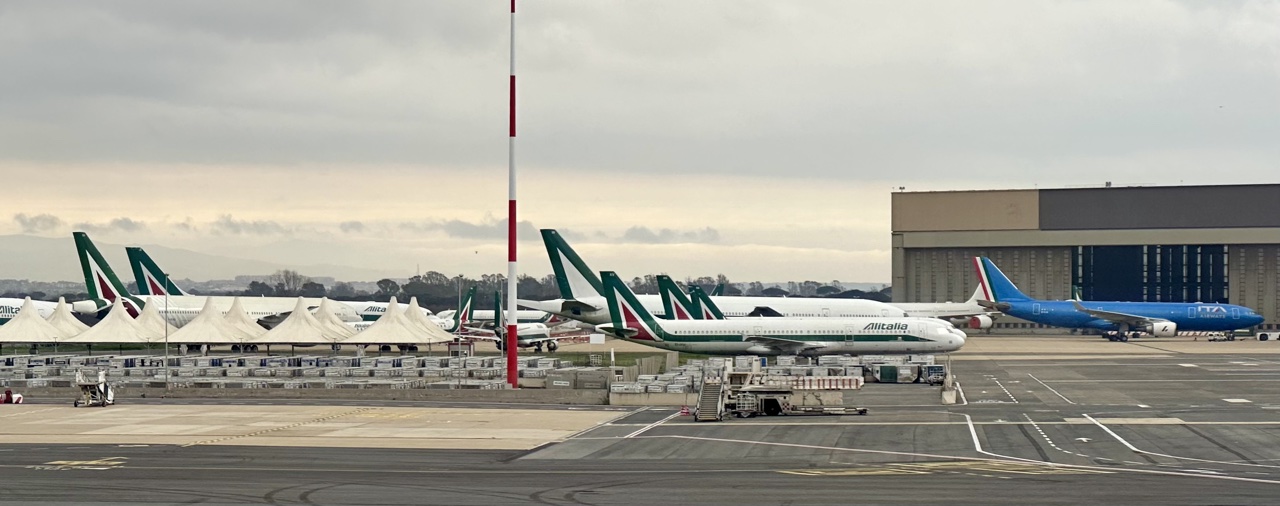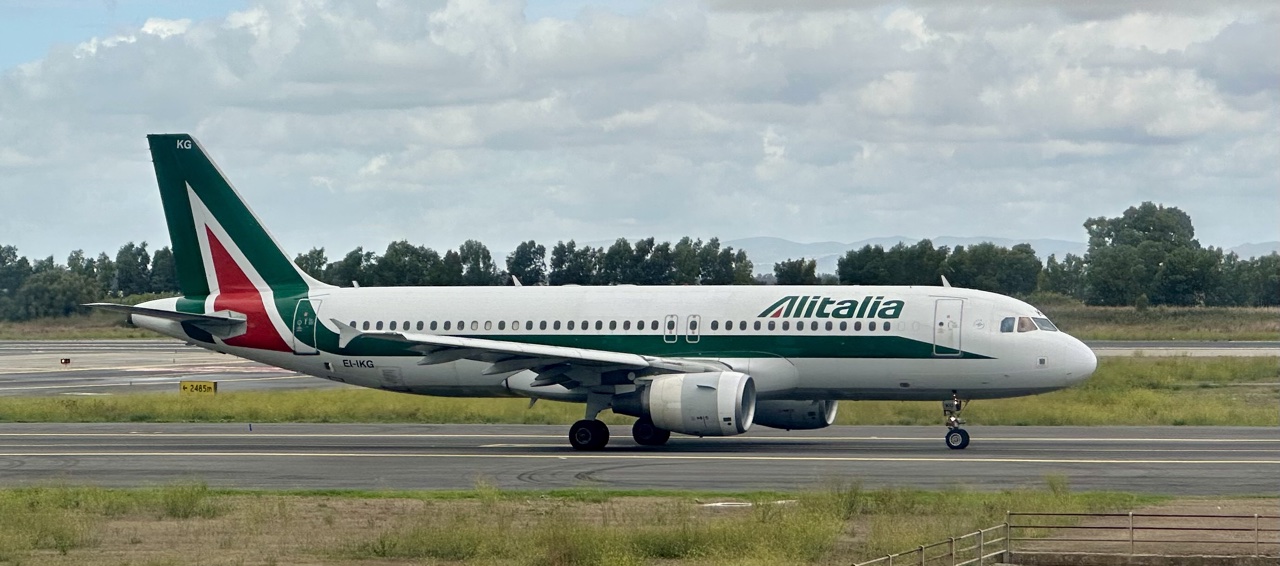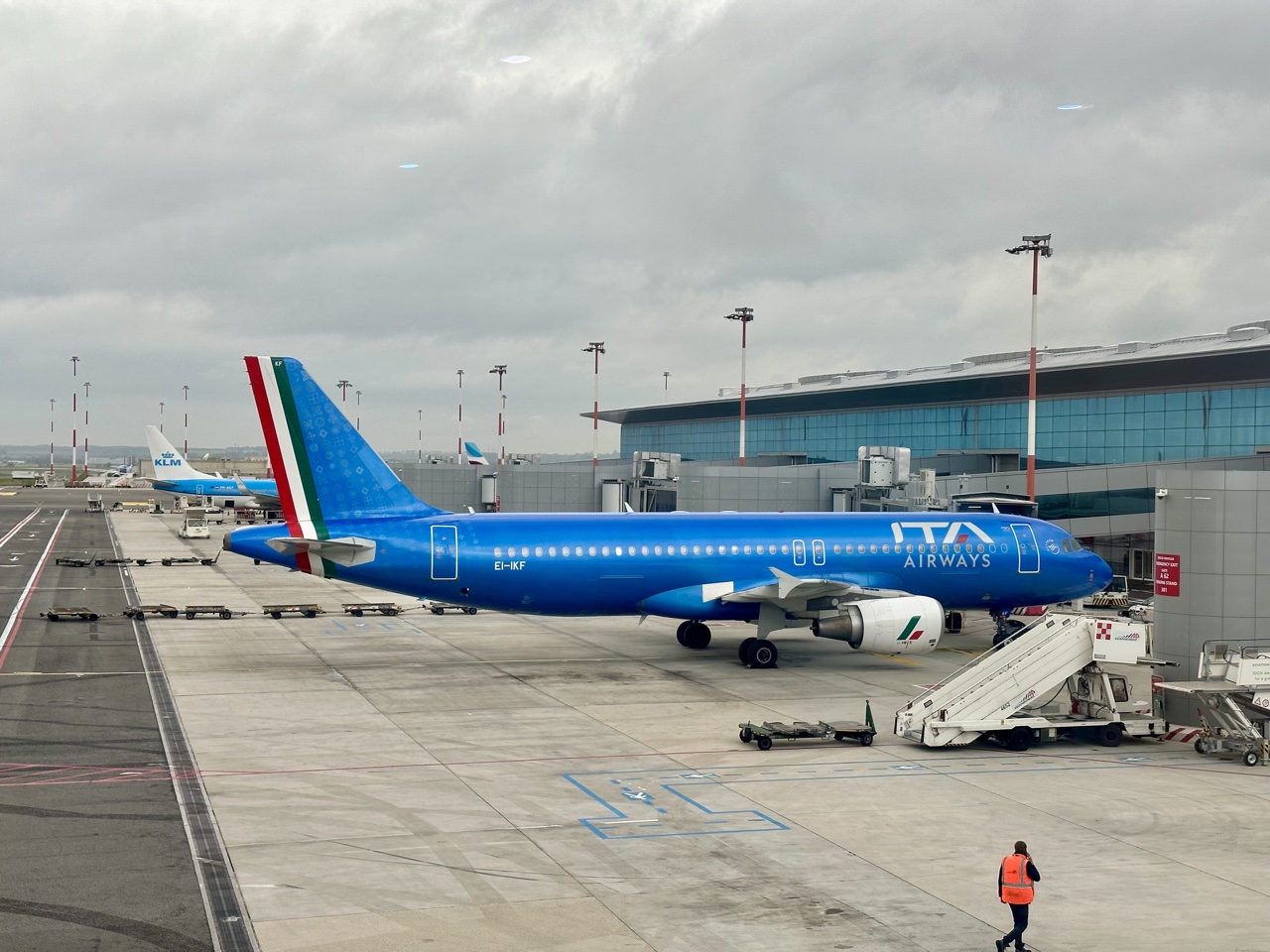Alitalia went out of business officially in 2021 with ITA replacing the storied carrier, but what’s going on with its aircraft?
If you are considering booking travel LiveAndLetsFly.com appreciates your support.
If you haven’t followed us on Facebook or Instagram, add us today.
From Alitalia Airlines To ITA Airways
Alitalia, Italy’s flagship airline, was established in 1946 and began operations in 1947, quickly becoming a symbol of Italian elegance and excellence in aviation. Throughout the mid-20th century, it grew to be one of Europe’s premier carriers, recognized for its impeccable service and stylish branding that reflected the sophistication of Italian culture. Alitalia carried millions of passengers across domestic, European, and intercontinental routes, often serving as the airline of choice for dignitaries and celebrities. Its role as Italy’s national carrier gave it a prominent place in global aviation, but prestige masked growing operational inefficiencies and financial instability.
By the 1990s and early 2000s, Alitalia faced mounting financial difficulties due to mismanagement, rising competition from low-cost carriers, and an inability to adapt to a changing aviation landscape. Efforts to restructure the airline were marred by labor disputes with unions, which resisted layoffs and wage reductions, making turnaround efforts increasingly difficult. Despite partial privatization and numerous government bailouts, Alitalia continued to operate at a loss, due to high debt and outdated models. In 2017, the airline filed for administration (more or less equivalent to US Chapter 11 bankruptcy protection), entering a prolonged period of uncertainty. Attempts to sell or relaunch Alitalia failed until 2020, when the COVID-19 pandemic devastated global travel, rendering its situation untenable.
In October 2021, Alitalia ceased operations, and its successor, ITA Airways (Italia Trasporto Aereo), was launched as a state-owned airline. ITA Airways inherited a leaner operational framework, fewer employees, and a restructured fleet to reduce costs and compete effectively. The new airline aimed to shed the legacy issues of its predecessor while preserving its Italian identity. ITA Airways adopted a refreshed branding strategy, modernized its fleet, and entered partnerships with major carriers to secure its place in the global aviation market.
While I can’t quite say I understand the restrictions around converting Alitalia to a state carrier from a private one, starting ITA fresh as a state carrier and then acquiring just the parts they liked of Alitalia is apparently fine.

Aircraft Transitioned to ITA Airways
As part of its relaunch, ITA Airways significantly downsized and modernized its fleet, initially acquiring 52 aircraft from Alitalia, including Airbus A319, A320, and A330s. These planes were chosen to streamline operations and focus on efficiency and sustainability. ITA Airways also committed to a fleet renewal plan, signing agreements to acquire next-generation aircraft such as the Airbus A220, A320neo, and A330neo, which offer improved fuel efficiency and reduced emissions. The transition marked a departure from Alitalia’s sprawling, inconsistent fleet strategy, signaling ITA Airways’ commitment to cost-effective and environmentally conscious operations.
What’s more interesting is the amount of aircraft that were not transferred and that the carrier apparently had no plans for them whatsoever.

Aircraft Stacked
Flying in or out of Rome Fiumicino International Airport will remind visitors looking out the windows that not all Alitalia aircraft were taken when ITA emerged as the sole Italian flag carrier following Alitalia’s collapse.
Alitalia had 156 aircraft, but ITA has just 56 and some of those aircraft are new. Aircraft that were not absorbed by ITA can be clearly seen parked around Rome’s airport and like others throughout the country.
It’s odd to see 777s stacked on the apron, some buttoned up for the foreseeable future, others appear ready to fly. An A320 had been parted out with at least one engine re-homed. While I can’t be certain how many A320 family aircraft are parked but whole, there’s like a handful or more that could give considerable lift to carriers in need. Yet still, some that didn’t make it into ITA’s fleet still seem to be functional, as late as September one was taxiing and then took off behind one of its ITA siblings.

Couldn’t This Be An Answer For Airlines Desperate For Aircraft?
Delivery delays due to engine issues for new, fuel efficient airplanes are costing airlines to the extent that some have stopped hiring much needed pilots. JetBlue, prior to the Spirit merger, wanted airplanes bad enough to not only overpay for the deal if approved (it wasn’t) but then also to cut Spirit shareholders a $400 million check.
The Spirit deal, which cost JetBlue even more than the Spirit shareholder checks they cut when including legal expenses, marketing, and PR, would have secured just over 100 jets. But they had to go through huge regulatory hurdles to achieve it and ultimately, failed. Imagine how much cheaper and easier it would have been to buy 17 A320-family aircraft and grow organically.

Aircraft and engine manufacturers, or their insurers, help cover airline offsets incurred by flying less efficient aircraft. While I am sure there are reasonable limitations to replacement equipment, some clever finagling could make it worthwhile for a carrier that already operates similar fleets. For example, United is desperately waiting for dozens of aircraft and just gave up all hope of the 737-MAX 10 joining the fleet, could it not grab some of Alitalia’s (6) 777-200s and adjust operations some? Wouldn’t it make sense to adjust busy 767s flying trans-Atlantic flights to a 777-200, then upguage a 757 route (or six) which then frees up the 757 fleet for A320 and 737-Max 10 routes that can’t be serviced? Couldn’t United easily swap the aircraft for Hawaii aircraft for which they seem to have no desire to convert the “coffin-class”, eight across business class sections – it would be a huge lift for flyers.
United’s need for A321 aircraft is different than just needing ANY A320/321 because it’s based on the mission it would serve. However, Frontier was looking to grow too. Southwest has just removed flights and reducing pilot count due to Boeing deliveries but unlike the other operators Southwest would lack an operational capability with adopting the A319/320/321 aircraft including pilots, training centers, and maintenance support.
What about a lessor who could get these aircraft up to snuff, and then lease out the fleet targeting airlines waiting for affected Airbus equipment? If the JetBlue acquisition had been approved, the carrier was already clear that they would completely overhaul the aircraft and make them JetBlue planes anyway. The Alitalia equipment is unquestionably older, but given that they have been out of business for three years, they should be available for a song.
Carriers that don’t have mission-specific requirements might be smart to take an incentive from Airbus to drop down the delivery list and receive a credit for the fuel efficiency differences. That would give airlines the ability to grow or replace equipment while airlines wait for delayed deliveries. The same applies to carriers that operate a mixed 737/A320 fleet but may be delayed due to the MAX slowdowns.
Imperfect Solution
There’s no question it’s an imperfect solution to any fleet needs. Alitalia aircraft would need to go through expensive checks, likely some repairs, and branding. It’s not a light switch to turn on and immediately solve fleet problems for carriers throughout the world.
However, the challenges are stacked against airlines:
- A nearly half decade long back order at both Boeing and Airbus
- Fraudulent materials in engine construction requires inspection, affecting completed airplanes at the manufacturers and pulling planes from the sky
- Sustained elevated demand
I drafted most of this post in March and just never got back to it. But Gary Leff, just this week, wrote about the 2,300 Alitalia staffers still on the payroll that have not been transferred to ITA and can’t be doing much of anything. Wouldn’t the sale of these aircraft cover a significant amount of payroll for a defunct airline, wouldn’t it pay some debtors back?
Assuming that the aircraft are too expensive to rehabilitate (despite at least the one pictured which is airworthy and those that were transferred to ITA already) certainly the parking fees alone at an airport like Rome Fiumicino would be a concern. Is it cronyism that’s keeping these aircraft parked on the tarmac?
Conclusion
It struck me as odd to see expensive, modern aircraft stacked in a major hub for what had to have been at least three years and perhaps longer with COVID restrictions. As the world seems to need as many of these aircraft as they can get their hands on, the Alitalia jets can’t seem to find a home. The costs have to be staggering and it seems odd, wasteful, and suspect.
What do you think? Why are the aircraft still parked? Why haven’t they sold?




This article is a trainwreck of delusion and arrogance masquerading as expertise. It’s almost painful to read something so utterly devoid of insight, yet dripping with the unwarranted confidence of someone who thinks staring at parked planes makes them an industry insider. You’re not clever, you’re not informed, and frankly, you’re embarrassing yourself.
Do you genuinely believe you’ve cracked the code on global fleet shortages with your half-baked ramblings about Alitalia’s leftovers? Spoiler alert: the world’s airlines don’t need your amateur guesses about how to “solve” their problems. Your “analysis” reeks of ignorance, and your suggestions are so absurd they’d be laughable—if they weren’t so pathetic.
It’s obvious you threw this article together without any real understanding of aviation, economics, or basic logic. You cherry-pick details to sound informed but fail miserably, leaving us with a disjointed, self-important rant that accomplishes nothing except showcasing your complete lack of expertise.
Here’s a reality check: no one in the aviation industry is waiting for your groundbreaking idea to park-hop Alitalia’s scrap heap into relevance. You’re out of your depth, out of ideas, and clearly out of anything meaningful to say. Stick to daydreaming about planes—leave the real analysis to people who know what they’re talking about.
Comment above endlessly insulting the article , but informing us of nothing .
Four paragraphs of insults do not a critic make .
I applaud the article enthusiastically because of the famous fulsomeness of Sophia Loren , and all of Italy’s girls .
@David I find both takes, Kyle’s and yours to be an interesting read.
First, Kyle’s: He seems to miss the obvious in that if these planes had value to carriers they would already be long gone. What is probably at play here is that they are mired in a bankruptcy and creditor’s fighting over assets and valuations. I have seen houses (as an example) in bankruptcy that had multiple banks lining up and none agreeing to the sales price. Lower tier creditors often blocking those with the most vulnerability because they are so far down the line of getting money. Those houses I have seen literally fall apart over time and take years in court battles to get to market. In Alitalia’s case, you can imagine hundreds of creditors all vying to be heard. It will take years to sort through the court system, especially in Italy.
For David, While you were really strong in your language, probably a bit too harsh, you make a valid point. However, you do so without giving any thoughts as to what your reasons are. One paragraph of calling the author out would have been plenty. At which point you could have then addressed the specifics of your argument which you failed to do.
@Atwerp – I agree that creditors are probably involved, but four years after shut down and three years after 75% had been sold and still they remained parked? Also, at least one of these was not completely worthless as photographed taxiing and then took off. Others had engines removed as mentioned. Perfect and ready for service, certainly not. Beyond repair or even for scrap? That seems unlikely and even if so, in three years they couldn’t have parted those out further? The other piece to point out is that ITA is currently flying plenty of these aircraft so even if these were the “not good enoughs” they were airworthy in early 2020, it seems odd that one year later they are worthless and no longer air worthy.
As the example I used, I have seen houses sit dormant for 10 years because creditors couldn’t agree on valuations and offers.
The planes moved over to ITA may have had little or no creditor issues so they were transferred without dispute. The others could have layered creditors or are being kept as part of a larger deal to be decided on down the road. That much debt for Alitalia would include a long scroll of battles.
As to stripping engines etc, a Judge could have seen this as a viable stop gap for creditors and lawyers in seeing some temporary solution while this works through years of Italian courts. Or, could be as simple as engineers saw issues developing on certain engines (they are not being stored in the best graveyard climate) so were moved to a more controlled environment.
Honestly, to me, if you write this kind of post, take the time to reach out to Italian contacts, authorities, or try and surface court proceedings to get the facts. I am sure there are reasons far reaching as to why they are not being sold to other airlines.
This seems like a poorly researched article. Almost all Alitalia aircraft were returned to their lessors, transferred to ITA, or found new homes at another airline. As far as I can see, no former Alitalia A319s or A320s, beyond 4 very old and clearly end-of-life A321-100s are still parked on the tarmac. Alitalia had actually already begun scrapping these prior to its demise.
Sure, there are also 5 777-200s that are still stored and were fully owned by Alitalia, but realistically, what is the market for buying 20+ yr old 777s that probably aren’t in great condition?
There is clearly nothing suspect about this – all aircraft that had any value have been brought back to service or sold away. ITA has no use for 777s after introducing new A350s and they were clearly too old and undesirable for other airlines to take on.
Also, the photo you posted is actually an A320, that has incidentally just been retired by ITA after being replaced by A320neos.
@James, there are A320 family aircraft in the photo but it is from some distance so it may be hard to see. However the one taxiing and subsequently flying away was taken by me in September. Are you asserting that the aircraft was retired, and repainted back to Alitalia colors before flying away?
I was referring to the 4th photo in the article, of EI-IKF, which is an A320 that was taken on by ITA Airways and then retired.
The one taxiing as you mention in the 3rd photo, EI-IKG, is still active and flying for ITA – it just hasn’t been repainted yet.
Wrong. These aircraft are still airworthy. ITA is not a well managed carrier. Italy deserves an efficient and major long haul flag carrier with a hub in Milan. A321s and 777s are cheap and easy to start with. ITA will never succeed with its current management.
AZ planes are old, parked for years and need significant and expensive maintenance, rebranding and new interiors. There’s no market for these aircraft at all
No market, I don’t quite agree. Perhaps not as rehabs, but. I suggest there is likely an excellent value in cannibalizing them.
I agree.
This is a poorly written article for sure, and full of assumptions. The AZ planes parked are mostly A320CEOs, A319CEOS, and B777-200ERs. The 320 and 319s are over 25 years old. The 772s were part of an order placed in 1999 that originally was for 5 747-400s (those went to Virgin Atlantic) and instead, AZ got 10 777-200ERs. They were delivered between 2002 and 2003. They are 21 years old. Not exceedingly old, compared to the 763s and 752s flying around today at DL and UA, but still, and feature cabin interiors that would need to be upgraded (not an easy thing to do right now given the difficulties in manufacturing for these). These are also probably leased planes, locked up, due to AZ’s bankruptcy and poor credit rating. In any case, there may be some market for some of these planes, but their value is likely to be more as the sum of their parts, and not as a whole airplane.
@shoeguy – Feel free to disagree with the content all day long, I appreciate the discourse. As you note these 772s are younger than the equipment that DL and UA decided to retrofit to a modern product and keep flying across the Atlantic and to South America but I pointed out (and agree) that manufacturing is generally a problem and who knows what they need. That said, somewhere in the world today (probably somewhere in Europe) there is 777-200 that will have to take a plane out of service rather than replace the engine while the problematic one is worked on (regardless of whether these are fitted with GE or P&W.) Somewhere in Europe right now, there’s an 772 that needs a replacement in its avionics, or a cargo door latch, or a horizontal stabilizer.
There’s a reason these are still sitting parked and mostly ready for action (or flying as the A320 I photographed, or flying for ITA) and I don’t know what that is. But with so much market demand it seems odd. Delta was quite happy to buy MD-80s for a song and fly old equipment to continue to grow routes years ago even after investing in modernizing the aircraft it already knew was inefficient, and short term. No one wants any of these? Doesn’t that seem strange?
It leads me to believe that can’t be had (or even parted out) but I can’t find why.
There is one other credible notion: the very reason Alitalia is out of business and still paying more than 2,000 staffers extends to its management of fleet – complete ineptitude. Everyone on this thread has suggested plausible, logic-based reasons when in truth, it’s entirely possible that something less logical is taking place. Perhaps arcane laws or poor management are to blame.
The majority of AZ’s remaining, legacy staff, some 2,000 employees, have just been given the boot. There’s not much left of the legacy AZ beyond the name.
Alitalia just became ITA and isn’t out if business, and also, the fleet strategy wasn’t sprawling…
@deltasucks – ITA is more clean sheet than I realized before looking into it. They bought just a handful of jets from the defunct Alitalia, rather different carrier in fact. Just feels like they changed the name and livery but there’s a lot more to it than that.